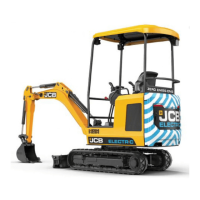Operation
Lifting and Loading
Lifting and Loading
General
WARNING A high load can block your view and reduce the machine's stability. Travel with the load low to
the ground. Travel slowly and with caution over rough, muddy or loose surfaces.
WARNING When transporting a load on a slope, drive slowly and keep the load uphill of the machine. This
will increase stability.
WARNING Do not use the machine for object handling unless it is equipped for this purpose. Without the
relevant devices the machine can become unstable and tip over. You and others could be seriously injured
or killed.
WARNING Before you lift a load with the machine, you must read and understand this section. Failure to
take the precautions shown can result in death or injury.
WARNING If your machine has not been installed with a lifting kit, an approved lifting point such as a hook
or shackle and hose burst check valves then it must not be used for object handling. Using a machine for
object handling without these devices could lead to injury. Use the machine for earth-moving purposes only.
If your machine is not installed with this equipment you must only use the machine for earthmoving purposes.
Lifting (Object Handling) Regulations
The owner and/or operator must make sure that they fully understand the laws and regulations concerning the
use of the JCB machine as an earthmover and for lifting. Consult your JCB dealer for more information.
In certain countries safety regulations in force call for the application of specific safety factors. Consult your
JCB dealer for more information.
All figures and lift capacities (if applicable) in this publication are based on the machine being on level, solid
ground.
Safe Working Loads
The maximum load which may be lifted depends on the equipment attached to the machine and the laws and
regulations in force at the time and in the country in which the machine is being used.
If your machine is equipped to be operated under 'Exemption Certificate' rules, your Exemption Certificate will
specify the safe working loads.
Fit for Purpose Tests for Lifting Equipment
All lifting equipment (for example forks, lifting hooks and shackles) needs regular inspections and testing by a
competent person to make sure they are fit for purpose. These may be needed every six months or at least
annually in some countries to meet and comply with legislation and for insurance purposes. Check with your
local JCB dealer for further advice.
Load Charts
The SWL (Safe Working Load) of the machine depends on how far the boom is extended and the angle it is
raised to.
All lifting operations must be carried out using the load charts in the cab/canopy. The load charts refer to the
lift capacities relevant to the machine specification when equipped with an approved JCB tipping link, shackle
and bucket ram.
The weights of buckets, slings and auxiliary devices must be deducted from these capacities. Care must be
taken to make sure that these loads are not exceeded.
If a load chart is not provided in the cab, the machine is not designed for lifting.
60 9831/8250-4 60
JCB © Admin Pimteam - 23/06/2021 05:32.

